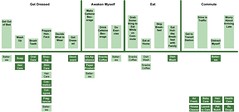Kevin Kelly established himself as an Internet pundit with true foresight with the 1998 New Rules for the New Economy which is still a classic, if showing a little age with its dot com bravura. Now he’s working on a new book piece by piece on his blog. The latest chapter examines the future of value online. In Better Than Free he posits:
“When copies are super abundant, they become worthless.
When copies are super abundant, stuff which can’t be copied becomes scarce and valuable.
When copies are free, you need to sell things which can not be copied.
Well, what can’t be copied?”
His answer is eight uncopyable values, which he calls “generatives”:
Immediacy — Sooner or later you can find a free copy of whatever you want, but getting a copy delivered to your inbox the moment it is released — or even better, produced — by its creators is a generative asset.
Personalization — A generic version of a concert recording may be free, but if you want a copy that has been tweaked to sound perfect in your particular living room — as if it were preformed in your room — you may be willing to pay a lot.
Interpretation — As the old joke goes: software, free. The manual, $10,000.
Authenticity — You might be able to grab a key software application for free, but even if you don’t need a manual, you might like to be sure it is bug free, reliable, and warranted.
Accessibility — Ownership often sucks… Many people, me included, will be happy to have others tend our “possessions” by subscribing to them.
Embodiment — …PDFs are fine, but sometimes it is delicious to have the same words printed on bright white cottony paper, bound in leather. Feels so good.
Patronage — It is my belief that audiences WANT to pay creators… But they will only pay if it is very easy to do, a reasonable amount, and they feel certain the money will directly benefit the creators.
Findability — …no matter what its price, a work has no value unless it is seen; unfound masterpieces are worthless.
 The Zollverein School in Essen, Germany was a great hope for the business design field, starting the first MBA of its kind in Europe. But this newspaper story lays out a tale of caution for anyone starting a venture like this. In short, it seems the gorgeous new building they constructed to house the school has become a real estate liability. Even with taxpayer funding, the operating costs are a burden.
The Zollverein School in Essen, Germany was a great hope for the business design field, starting the first MBA of its kind in Europe. But this newspaper story lays out a tale of caution for anyone starting a venture like this. In short, it seems the gorgeous new building they constructed to house the school has become a real estate liability. Even with taxpayer funding, the operating costs are a burden.





